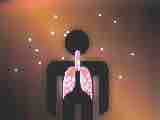Airborne Transmission of Disease
Airborne diseases are characterized by diseases that are transmitted through the air via the presence of a pathogen. These pathogens can include both viruses and bacteria that are spread by coughing, sneezing, laughing, or through personal contact. The pathogens are capable of traveling distances on air currents when they are present on either dust particles or small respiratory droplets. The airborne transmission that occurs utilizes small particles or droplet nucleithat contains these infectious agents or pathogens. These particles and droplets are capable of remaining suspended in air for extended periods of time. Inhalation of these particles results in respiratory tract infection. The ability of these droplets to remain suspended for long periods of time result in the lack of face-to-face contact for infection. The ability of these pathogens to survive and retain their ability to infect for relatively long periods of time add to the difficulty encountered in their prevention and targeting .

Airborne transmission
Infection of the respiratory system via airborne transmission.
Often times, these airborne pathogens can result in inflammation in the nose, throat, sinuses, and the lungs. The symptoms such as sinus congestion, coughing, and sore throats are examples of inflammation of the upper respiratory airway. Many types of infections that can be a result of airborne transmission include: Anthrax, Chickenpox, Influenza, Measles, Smallpox, and Tuberculosis. Airborne diseases are caused by exposure to a source such as an infected individual or animal.
Airborne transmission of disease is common in unsanitary household conditions and overcrowded areas, and pathogens that are transmitted in this manner thrive in areas of poverty and poor hygienic conditions. For example, tuberculosis is common in individuals from developing areas in the world, adding to 95% of cases worldwide.